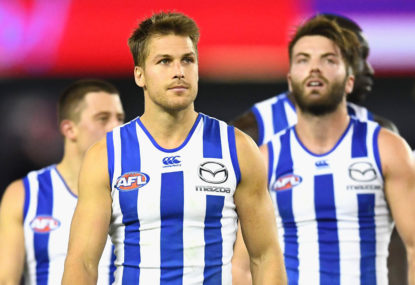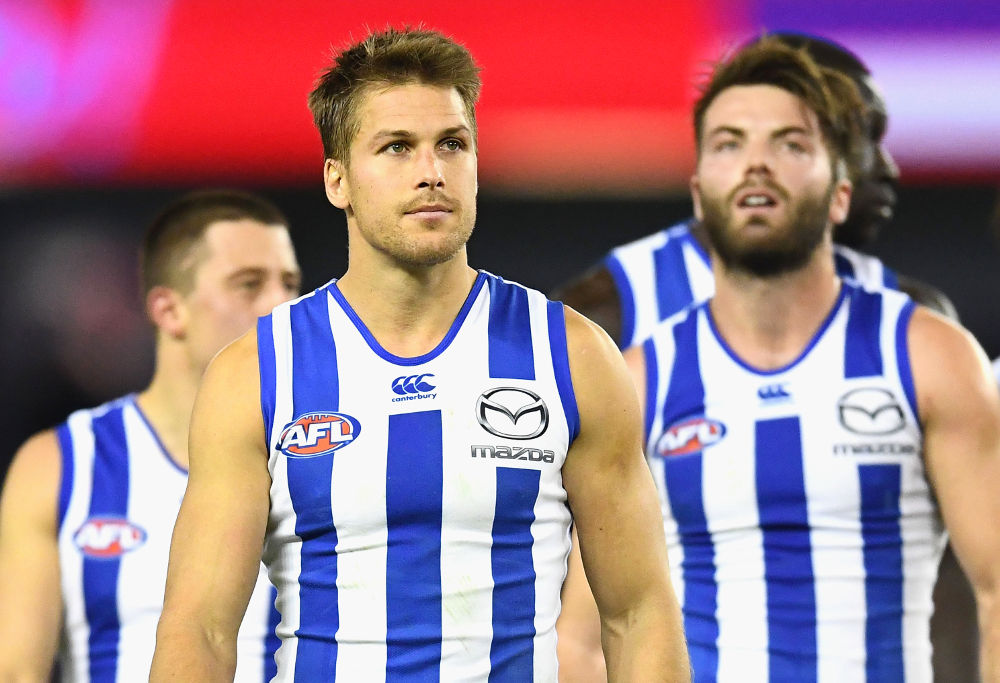The crucial cogs of AFL's Round 7: Which players need to be the difference makers?
We’re taking a look at one player from each team that needs to make a difference this week, starting with the ANZAC Day games.

Last year, North Melbourne finished 15th on the ladder and have no choice but to rebuild.
It’s not a lost cause. The Kangaroos have made the finals in four of the past eight seasons, including two ninth-place finishes. But lack of firepower has, throughout this era, negated them from being one of the more successful Victorian teams.
2016 was the last of many times the Kangaroos were kicked out via an elimination final. They also lost a host of experience; Brent Harvey, Nick Dal Santo, Michael Firrito and Drew Petrie weren’t offered new contracts for 2017.
But let’s backtrack 45 years to a time when North Melbourne began one of the most famous rebuilds the game has ever seen – a time when there were just 12 teams competing in what was then known as the VFL.
Finishing fourth in 1958 was followed by 13 successive seasons without a finals berth, and North Melbourne had only ever played off in one grand final in its history, back in 1950.
The Kangaroos’ average ladder position between 1958 and 1972 was ninth, which includes finishing on the bottom of the ladder on four occasions.
Enter: the ten-year rule.

(Photo by Quinn Rooney/Getty Images)
Similar to what’s now known as Free Agency, the VFL board came together and decided that a player who has served ten years with a club is eligible to move to the club of his choice.
This rule was enforced at the conclusion of the 1972 season, when the Kangaroos had lumbered their way to the wooden spoon.
In a matter of months, the league decided the rule caused too many problems. In May of 1973, it was scrapped.
Despite the ten-year rule’s short-lived presence in the game, its influence would long be spoken about.
After obtaining the signatures of Essendon’s Barry Davis, South Melbourne’s John Rantall and Geelong’s Doug Wade, North Melbourne had benefited most and would soon become the envy of the competition.
After one more season, the Roos competed in the 1974 grand final. It would be the first of five consecutive appearances.
“Almost as soon as they allowed that rule, the VFL withdrew it, so we were very fortunate,” North Melbourne historian Father Gerard Dowling said of the club’s luck in gaining three stars of the competition.
“We also got Barry Cable from Perth. He wasn’t subject to the ten-year rule, but he came across for one season in 1970, left, and then came back and was a big part in that era.”
But while people will sit there and criticise North Melbourne’s tactics of not breeding their own, Dowling conceded that there are a number of reasons the Kangaroos rose back up the ladder, and one of them was AFL legend Ron Barassi.
“He [Barassi] was the captain of Melbourne. He left them and became captain-coach with Carlton and won two premierships. He gave it up then was persuaded out of retirement to come to North,” Dowling said.

“He had a tremendous fierceness and the knowledge to help us win our first league premiership in 1975.
“We were able to work out a deal. Al Mantello, he was the one who had a say in helping lure Ron to the club. It proved crucial.
“Credit really has to go to Ron Barassi. Our failure in ’74 was the thing that triggered off the reaction (becoming the most dominant side in the competition).”
Every man and his dog knows that grand finals are difficult to win. North claiming two premierships (1975 and 1977) could be seen as one of the more remarkable dynasty’s considering where the club came from.
But to others, they underperformed.
“We should have won at least three [premierships] in a row in that time,” Dowling claimed.
But the effect of giving long-suffering North Melbourne supporters something to cheer about was the real beauty and importance of this famous revival, given what their faithful had recently endured.
“The mood among the supporters was just tremendous,” Dowling said.
“1965 I think it was, we didn’t have control of the Arden Street ground. We went out to Coburg for one year, and then we came back to North Melbourne and we were in charge of the ground…it made things much more able.
“A key person to the whole thing was Allen Aylett, who had been one of their best players, became chairman and was one of the ones who went for Ron Joseph and Al Mantello. They were the people who masterminded the whole plan and broke the North Melbourne stranglehold,” he continued.
“We had been in a grand final in 1950 and it was the only grand final we went in since we came into the league in 1925, so Allen Aylett, Ron Joseph…they were the people who really masterminded the whole procedure.”
Davis finished his career with 71 games and 54 goals for North Melbourne, while John Rantall (70 and two) and Doug Wade (59 and 223) also ended their two-year stint at Arden Street following the 1975 premiership success.
The controversial ten-year rule was ultimately annulled by the VFL board as every club in the competition complained about North’s three additions and sudden change of fortune.
“I think it’s like everything else. Once you start showing success, people gather around,” Dowling said.
“North had struggled for membership but gradually that was the beginning, we are the fourth-oldest club of the 18 teams there are at the moment, founded in 1869.
“With success, we attracted people, all those sort of features helped us a lot. All those factors turned us around.”
Following North Melbourne’s success in 1975 and 1977, they’re remembered as one of the most dominant football teams in the history of our game.
Unfortunately, if the 2018 Kangaroos want to match that turnaround, they’ll have to do it the hard way.